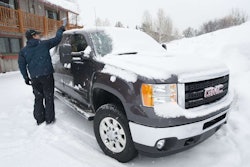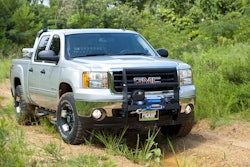Lockers & Limited Slips: Weapons of Mass Traction
By Mike Magda
An inside look at differential upgrades to enhance off-pavement performance for old pickups and those with modern electronic traction controls
Almost every new full-size pickup comes equipped with an electronic traction control that is part of the vehicle’s ABS and stability control system.
The same network of sensors, computers, valves and solenoids that keep the brakes from locking up under panic stops can also detect if a drive wheel is spinning faster than the other wheels, which indicates a loss of traction.
The system quickly reacts by applying the brake on the spinning wheel, which transfers torque across the axle to the tire with greater traction when in two-wheel-drive or, if needed, to the opposite axle when in four-wheel-drive. The computer can also reduce engine power until all the drive wheels share the workload evenly.
Electronic traction control is effective in the majority of routine driving situations, especially on ice or snow-packed roads. The sophisticated programming that makes split-second adjustments to control the tires is well beyond the driving capability of most drivers.
 Working on highway job sites like this can be a nightmare if your pickups don't have lockers and decent tires.
Working on highway job sites like this can be a nightmare if your pickups don't have lockers and decent tires.
Besides helping achieve maximum grip for braking and acceleration, brake controls can also help the driver maintain the desired course in a turn (electronic stability control) and reduce trailer yaw (trailer sway control).
Despite all their wonderful attributes in day-to-day driving, electronic traction controls have shortcomings in more severe applications such as off-highway use.
So most automakers still offer optional mechanical traction aids, such as a limited-slip differential (LSD) or a locking differential.
The Toyota Tundra is the only full-size pickup that does not offer a mechanical LSD or locker.
But it has advanced programming options in its electronic traction controls to help drivers get out of difficult situations.
Besides increased brake-pad wear, the biggest drawback to electronic traction controls is that they may cut engine power and work to eliminate all wheelspin.

Ford offers an electronic-locking differential for the rear axle on most Super Duty SRW axles. Other 2500/3500 trucks can get a limited-slip differential option for the rear, but there may be some restrictions depending on the trim level.
For situations such as climbing a steep hill on loose dirt or slogging through deep sand, the driver needs power and some wheelspin to maintain momentum or “dig out.
” That’s where the mechanical traction aids provide the most effective assistance.
The other big drawback is driver frustration when the computer intrudes during aggressive off-roading, like when you lay into the throttle in sand or heavy mud to get the tires to clean and keep forward momentum.
Pickup manufacturers give drivers the option to turn off traction and stability controls, and some vehicles do it automatically when in certain 4WD modes.
But even that might not be enough to keep your truck from getting stuck.
Traction Upgrades
The work and recreational needs of many truck owners may require upgrading of a stock vehicle’s drivetrain with some type of mechanical traction assistance. The actual workload and owner’s pocketbook will determine the best option.
Limited-slip differentials have been around since the ‘50s. They may use internal friction clutches – either flat or cone style – or a unique worm-gear arrangement to limit torque to the spinning wheel and transfer power to the wheel with greater traction.
Clutch-type LSDs will wear out and need to be serviced or replaced. Currently there is only one gear-type LSD in the aftermarket, so availability may be a problem.
Most truck owners seeking a traction upgrade prefer a locker. There are two types: automatic and selectable.
 Traction is a critical component of snow plowing situations.
Traction is a critical component of snow plowing situations.
The automatic locker distributes torque equally to both wheels at all time by literally locking the axes together.
When going through a turn, the locker “unlocks” and allows the outside wheel to rotate faster than the inside wheel. The unit then locks again when torque is applied.
Automatic lockers are strong but also noisy, may increase tire wear and may deliver a harsh ride on the street.
These aftermarket automatic lockers are not to be confused with the factory automatic lockers that normally run with an open differential then automatically engage the locked mode when sensing wheelspin.
The selectable locker allows the driver to move between an open differential for normal use and a fully locked axle for off-roading or inclement weather.
Depending on the model of locker, the driver operates the locker electrically, pneumatically or with a hand cable.
Selectable lockers are the most expensive and installation is more complex. But the driver has full control over the locking function, so street performance is unaffected while in the unlocked mode.
Adding an aftermarket LSD or locker shouldn’t interfere with the factory traction controls, but problems can always surface with warranty issues if the claim can be traced to improper installation or design flaws.
Also, some aftermarket differentials are extremely strong and may strip the axle splines if bigger tires are installed on the truck.
PRODUCT SHOWCASE
Auburn offers two versions of its LSD, including a Pro Series that has a more aggressive torque bias. Heavier trucks should certainly consider the Pro Series. The Auburn LSD is a cone-clutch design and requires a friction modifier additive in the lubricant. Cone-clutch LSDs are not rebuildable because the cones are specifically matched to the case; however, cone LSDs generally last longer than clutch types. Also, Auburn has a D-REX program so owners with units less than four years old can trade in for a new Auburn LSD for the about the same cost to rebuild a comparable clutch-type LSD. Street price: $325 to $650 for the standard LSD and $400 to $550 for the Pro Series.
A quiet and smooth-operating LSD, the Truetrac utilizes a helical gear design and is pretty much maintenance free and doesn’t require a friction-modifier in the lubricant. It’s built with forged gears under tight tolerances for a strong mesh. The design is fully automatic. Long-time enthusiasts may remember this differential under the Tractech brand, which was purchased by Eaton about six years ago. The Truetrac is often a strong choice for a front differential due to its negligible impact on steering and tough reputation, but experts may warn against using tires over 33 inches tall. Street price: $375 to $750
The Eaton Posi hasn’t changed in design but materials and tolerances are much improved since the unit was first introduced in the ‘50s. The Posi uses carbon-disc clutch packs that are preloaded by a central spring assembly and located behind each differential side gear. One of the Posi’s benefits is that it can be “tuned,” depending on the spring strength and the preload. The Posi can also be rebuilt after the clutches wear out. While the Posi isn’t the most effective traction-control option, it’s affordable and has built one of the most loyal followings of any automotive brand. For those truck owners with an open rear differential seeking additional traction for a tow rig or those worried about inclement weather, the Posi merits strong consideration. Street price: $475 to $800
The Detroit Locker is arguably the cornerstone of the traction-improvement aftermarket, especially for off-highway activities. It’s used from NASCAR to Trophy Trucks with proven success, but that doesn’t mean it’s the right choice for trucks driven mostly on the street. The Detroit Locker is notorious for noisy and clunky operation while making a turn. Some owners complain of a slight driveline slop or backlash. However, when traction is needed, both tires are locked together and there is no wheel-speed differentiation. Some truck owners like to use Detroit Lockers up front since they use 4WD only off roading or in snow/ice conditions and the extra weight of the engine helps add grip. Detroit Lockers also have one of the widest application ranges of any LSD or locker. Street price: $450 to $800
Richmond Powertrax NoSlip
The Lock-Right is an economical version of a full locking differential. It installs into a standard open differential carrier without special tools. Like other lockers, it will make a ratcheting noise as the driver disengages from the coupler teeth repeatedly through a turn, which allows the outside axle to turn faster than the inside wheel. The Powertrax NoSlip provides the same locking performance but with better manners. It features a synchronizing ring that holds the driver away from the coupler teeth. This additional engineering also adds a little cost. Neither version is available for any American Axle Manufacturing (AAM) axle that is original equipment on late model vehicles. Street price: $375 to $600 for the Powertrax No-Slip and $300 to $425 for the Lock Right.
ARB offers an extensive catalog for a variety of vehicles. Perhaps the best-known locker worldwide on the market today, the ARB does require an air compressor and careful routing of the air lines. For active off-roaders or those who tow in sand and need to air down tires, an on-board air compressor is always useful. In normal operation, the ARB performs like an open differential. With the flick of a switch, the driver can engage the locking mechanism – which prevents the differential gears from rotating – on the fly within a reasonable speed. When the driver hits the switch again, a solenoid releases the air pressure inside the differential seal housing and the clutch gear moves out of position to unlock the differential gears. Should an accident occur on a trail that damages an air line, ARB offers a repair kit. Hardcore off-roading can sometimes cause a leak in the seals. Again, ARB offers repair kits. Most problems with air leakage, however, stem from poor installation or nor following suggested maintenance. Street price: $800 to $925 plus cost of air compressor or storage tank system.
The Eaton E-Locker uses an electromagnetic mechanism to lock both wheels when the driver hits the switch. The basic construction of the E-Locker is a 4-pinion, collar-style design. When it was first developed in the late ‘90s, the unit featured a series of pins that locked the side gear to the differential case. The new style with a locking ring has broadened the application possibilities. The locking mechanism can be engaged at speeds up to 20mph as long as the wheels are turning at the same rate. In other words, you can’t lock it on the fly if one wheel is spinning more than 50 rpm faster than the other. The kit includes all necessary switches and wiring. Street price: $700 to $950
Instead of offering an open differential when the locking mechanism is disengaged, the Auburn ECTED is a clutch-type limited-slip differential in standard mode. This provides a little added traction control but the bias is not set up so firm that steering or ride comfort is affected. As with other electronic lockers, when activated an electromagnet fully locks the clutches together – there is no gear-type engagement with pins or shift forks that must engaged. That allows for activation at almost any speed. Officials say the design is watertight, so boaters need not worry about going under water to launch their craft. As with the Auburn LSDs, the ECTED is covered under a replacement warranty. Street price: $775
Very popular with modified Jeeps and rock crawlers for its stout construction, the OX Locker has limited applications in the full-size truck market. The OX functions similar to the ARB but has three options for actuation: hand-operated cable, electric and pneumatic. The OX provides full locking capability when engaged and an open differential when disengaged. All OX lockers come with a unique diff cover that is integral to the operation. Street price: $850 to $950 (additional cost may be required, depending on actuation method)

















